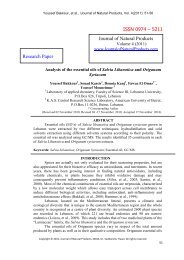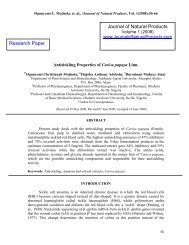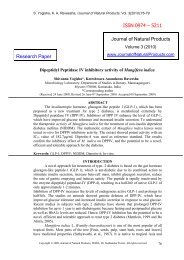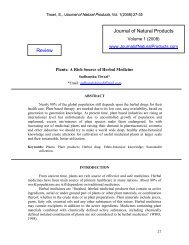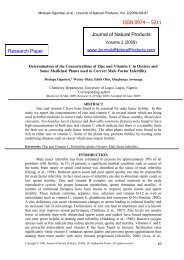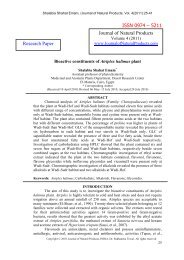Analysis of the essential oil and iridoide glucosides - Journal of ...
Analysis of the essential oil and iridoide glucosides - Journal of ...
Analysis of the essential oil and iridoide glucosides - Journal of ...
Create successful ePaper yourself
Turn your PDF publications into a flip-book with our unique Google optimized e-Paper software.
Heba Ibrahim Abd El-Moaty, /<strong>Journal</strong> <strong>of</strong> Natural Products, Vol. 3(2010): 103-111<br />
On <strong>the</strong> o<strong>the</strong>r h<strong>and</strong> iridoid glycosides were found in many medicinal plants <strong>of</strong><br />
family Lamiaceae <strong>and</strong> responsible for <strong>the</strong>ir pharmaceutical activities, where <strong>the</strong><br />
isolated iridoid exhibit a wide range <strong>of</strong> bioactivities including cardiovascular,<br />
antipheptotoxic, chlorectic, hypoglycemic, anti-inflammatory, antispasmodic,<br />
antitumor, antiviral, immunomodulator <strong>and</strong> purgative activities (Didna, 2007), while<br />
Yang et al., (1983) detected aucubin in Aucuba japonica <strong>and</strong> protected against liver<br />
damage induced by carbon tetrachloride or alpha-amanitin in mice <strong>and</strong> rats when<br />
80 mg/kg was dosed intraperitoneally. Hence we choice Nepeta septemcrenata for<br />
studying its main components as <strong>the</strong> previous literature did not included any reports<br />
about its active constituents <strong>of</strong> volatile <strong>oil</strong> or its iridoid glycosides.<br />
MATERIALS AND METHODS<br />
Plant material: Aerial parts <strong>of</strong> Nepeta septemcrenata were collected at full flowering<br />
stage from Kathrine [(Wadi Cherage, as identified by local Bedouin) in March 2006.<br />
Isolation <strong>of</strong> <strong>the</strong> <strong>essential</strong> <strong>oil</strong>s: Fresh aerial parts <strong>of</strong> Nepeta septemcrenata (100g) were<br />
hydrodistilled in a cleveger-type apparatus (Denny, 1989). After 3h <strong>of</strong> distillation, <strong>the</strong><br />
<strong>essential</strong> <strong>oil</strong>s were removed from <strong>the</strong> surface <strong>of</strong> <strong>the</strong> water. The <strong>oil</strong>s were dried over<br />
anhydrous sodium sulphate, stored in sealed dark glass vials <strong>and</strong> kept in refrigerator<br />
for fur<strong>the</strong>r analysis.<br />
GC-MS analysis: GC-MS analysis was carried out on a Hewlett-Packard 6890 gas<br />
chromatograph fitted with a fused silica HP-5MS capillary column (30 m × 0.25 mm;<br />
film thickness 0.25 µm). The oven temperature was programmed from 60ºC at<br />
3ºC/min. Helium was used as carrier gas at a flow rate <strong>of</strong> 2 ml/min. The gas<br />
chromatograph was coupled to a Hewlett-Packard 6890 mass selective detector. The<br />
MS operating parameters were: ionization voltage, 70 eV; ion source temperature<br />
200ºC.<br />
Identification <strong>of</strong> components <strong>of</strong> <strong>the</strong> volatile <strong>oil</strong> was based on retention indices<br />
relative to n-alkanes <strong>and</strong> computer matching with <strong>the</strong> WILEY 275. L liberary, as well<br />
as by comparison <strong>of</strong> <strong>the</strong> fragmentation patterns <strong>of</strong> <strong>the</strong> mass spectra with those<br />
reported in <strong>the</strong> literature (Adams, 1995; Swigar <strong>and</strong> Silverstein, 1981).<br />
Isolation <strong>of</strong> iridoid glycosides: About 1kg <strong>of</strong> <strong>the</strong> air dried parts <strong>of</strong> Nepeta<br />
septemcrenata were extracted with methanol-water mixture (80%). The combined<br />
alcoholic extracts were evaporated in vacuum at 40ºC, where <strong>the</strong> alcoholic extract was<br />
mixed with celite, dried, packed into a glass column <strong>and</strong> successively eluted with<br />
petroleum e<strong>the</strong>r 40-60ºC (fraction a), methylenechloride (fraction b),<br />
methylenechloride-methanol (1:1) (fraction c) <strong>and</strong> finally with methanol (fraction d).<br />
Each fraction was evaporated <strong>and</strong> tested for iridoid glycosides. Only one fraction<br />
which was eluted with methylenechloride-methanol (1:1) gave a positive test for<br />
iridoid glycosides (Trim <strong>and</strong> Hill reagent) according to Trim <strong>and</strong> Hill (1952).<br />
Thin layer chromatography <strong>of</strong> fraction ©: Thin layer chromatography <strong>of</strong> iridoid<br />
glycosides containing fraction © using silica gel plate 60 DF254 (Riedel De Haen)<br />
<strong>and</strong> <strong>the</strong> solvent system chlor<strong>of</strong>orm- methanol- water (80:18:2), where <strong>the</strong> sprayed<br />
reagent was 2N sulphuric acid, followed by heating at 110ºC for 5 min.<br />
Column chromatography <strong>of</strong> fraction ©: Fraction © was subjected to column<br />
chromatographic fractionation using silica gel (0.063-0.2 mm) Merck, packed into a<br />
glass column <strong>and</strong> eluted with methylenechloride-methanol-water (80:18:2). Fraction<br />
200 ml each were collected <strong>and</strong> monitored by thin layer chromatography, where<br />
similar fractions were collected toge<strong>the</strong>r <strong>and</strong> tested for iridoid glycosides (Trim <strong>and</strong><br />
Hill reagent). The positive test was re-chromatographed on silica gel (0.01-0.04 mm)<br />
column Merck <strong>and</strong> elution was performed with chlor<strong>of</strong>orm-methanol (95:5), followed<br />
Copyright © 2009, <strong>Journal</strong> <strong>of</strong> Natural Products, INDIA, Dr. Sudhanshu Tiwari, All rights reserved 104
Heba Ibrahim Abd El-Moaty, /<strong>Journal</strong> <strong>of</strong> Natural Products, Vol. 3(2010): 103-111<br />
by increasing amounts <strong>of</strong> methanol in <strong>the</strong> ratios <strong>of</strong> (90:10), (80:20), (70:30), (50:50)<br />
<strong>and</strong> finally with methanol. Also similar fractions were collected toge<strong>the</strong>r <strong>and</strong> tested<br />
for iridoid glycosides (Trim <strong>and</strong> Hill reagent) <strong>and</strong> <strong>the</strong> positive test was preparative on<br />
thin layer chromatography using <strong>the</strong> solvent system chlor<strong>of</strong>orm- methanol- water<br />
(80:18:2) <strong>and</strong> each b<strong>and</strong> was eluted with methanol 90%, where it was contained a<br />
single spot <strong>and</strong> three compounds were separated <strong>and</strong> purified from <strong>the</strong> eluted b<strong>and</strong>s.<br />
Ultraviolet spectrophotometric analysis (UV): Chromatographically pure materials<br />
were dissolved in pure methanol <strong>and</strong> subjected to ultraviolet spectrophotometric<br />
investigation using Shimadzu UV visible recording spectrophotometer UV-240.<br />
Mass spectrometric analysis (MS): The mass spectrum was conducted using finnigan<br />
SSQ 7000 <strong>and</strong> MM 7070 E.<br />
1 H-Nuclear Magnetic Resonance <strong>Analysis</strong> ( 1 H-NMR): The NMR measurements<br />
were carried out on A JEOL EX-270 NMR spectrometer apparatus (270MHz).<br />
Antimicrobial activity: The antimicrobial activity <strong>of</strong> <strong>essential</strong> <strong>oil</strong> <strong>of</strong> N. septemcrenata<br />
was tested against six gram-negative or gram-positive bacteria (Bacterial strains:<br />
Bacillus subtilis, Staphylococcus aureus, Micrococcus leteus, Escherichia coli,<br />
Salmonella sp. <strong>and</strong> Pseudomonas sp.) <strong>and</strong> seven fungi (Aspergillus niger, Aspergillus<br />
flavus, Fusarium solani, Fusarium oxysporium, Microsporum fulvum, Alternaria<br />
tennius <strong>and</strong> Yeast).<br />
The microorganisms were obtained from Plant Pathology <strong>and</strong> Microbiology<br />
Department, <strong>the</strong> National Research Center, Cairo, Egypt. It was checked for purity<br />
<strong>and</strong> identity <strong>and</strong> regenerated to obtain active microorganisms. The cultures were<br />
stored in refrigerator at 5ºC <strong>and</strong> reactivated on <strong>the</strong> media suitable for each<br />
microorganism.<br />
Preparation <strong>of</strong> <strong>the</strong> Spore Suspension: Bacteria inocula, consisted <strong>of</strong> 18 hours<br />
cultures grown in nutrient broth at 37ºC, where serial dilutions were made to prepare a<br />
suspension containing 105 cells/ml. Fungi were grown on slants <strong>of</strong> potato-dextrose<br />
agar (PDA) media <strong>and</strong> incubated for 7 days at 25ºC + 2ºC. Spores were harvested by<br />
adding sterilizing solution (between 80: 0.42 v/v) <strong>and</strong> filtered through several layers<br />
<strong>of</strong> cheese cloth. The number <strong>of</strong> conidia was estimated by hemocytometer <strong>and</strong> <strong>the</strong><br />
suspension was adjusted to contain approximately 105 spores/ml (Padwal, et al.,<br />
1976).<br />
Agar diffusion method: Agar diffusion method was used to check <strong>the</strong> presence or<br />
absence <strong>of</strong> antimicrobial agents by using <strong>the</strong> agar diffusion method as described by<br />
Booth (1972). The plates were separately inoculated on to <strong>the</strong> surface <strong>of</strong> appropriate<br />
nutrient media (nutrient agar for bacteria <strong>and</strong> PDA) for fungi. After inoculation <strong>of</strong> <strong>the</strong><br />
organism in each plate, four cups <strong>of</strong> one centimeter diameter were achieved in each<br />
plate by using a sterilized cork borer, three for <strong>the</strong> extract <strong>and</strong> one for <strong>the</strong> control<br />
solution <strong>of</strong> 1 %, in sterile water or <strong>the</strong> selected solvent. By sterile pipettes 4 drops <strong>of</strong><br />
<strong>the</strong> vegetative parts <strong>and</strong> legumes extracts (250, 500, 1000 <strong>and</strong> 2000 ppm) were<br />
transferred into <strong>the</strong> cups. All steps <strong>of</strong> <strong>the</strong> experiment were done under sterile<br />
conditions. Nutrient agar plates were incubated at 37 ºC for 24 hours, while fungi<br />
were incubated at 28ºC + 2ºC for 5 days. The zone <strong>of</strong> inhibition was measured at least<br />
in two diameters (in mm).<br />
RESULTS<br />
Identification <strong>of</strong> <strong>the</strong> <strong>essential</strong> <strong>oil</strong>s: The aerial parts <strong>of</strong> Nepeta septemcrenata yielded<br />
0.4% <strong>of</strong> clear yellowish <strong>oil</strong>, where thirty nine components, representing 98.3% <strong>of</strong> <strong>the</strong><br />
total <strong>oil</strong> were detected <strong>and</strong> <strong>the</strong>ir percentages <strong>and</strong> shown at table 1. The major<br />
Copyright © 2009, <strong>Journal</strong> <strong>of</strong> Natural Products, INDIA, Dr. Sudhanshu Tiwari, All rights reserved 105
Heba Ibrahim Abd El-Moaty, /<strong>Journal</strong> <strong>of</strong> Natural Products, Vol. 3(2010): 103-111<br />
separated constituents were 4aα, 7α, 7aβ-nepetalactone (24.2%), 4aα, 7α, 7aαnepetalactone<br />
(19.9%), elemol (13.8%), 1, 8-cineole (8.5%), linalool (5.6%).<br />
Identification <strong>of</strong> iridoid (1): UV spectral data (λmax, nm) <strong>of</strong> iridoid glycoside in<br />
MeOH was 220. Its mass spectrum showed molecular ion peak (M + ) at m/z 348 (calc.<br />
for C15H24O9). 1 H-NMR spectral data <strong>of</strong> <strong>the</strong> compound illustrated at table (2) showed<br />
a comparison <strong>of</strong> <strong>the</strong> compound with au<strong>the</strong>ntic ajugol. The illustrated data <strong>of</strong> iridoid<br />
(1) was found to be identical with ajugol.<br />
Identification <strong>of</strong> iridoid (2): UV spectral data (λmax, nm) <strong>of</strong> iridoid glycoside in<br />
MeOH was 224. Its mass spectrum showed molecular ion peak (M + ) at m/z 390 (calc.<br />
for C17H26O10). 1 H-NMR spectral data <strong>of</strong> <strong>the</strong> compound illustrated at table (3)<br />
showed a comparison <strong>of</strong> <strong>the</strong> compound with au<strong>the</strong>ntic ajugoside. The illustrated data<br />
<strong>of</strong> iridoid (2) was found to be identical with ajugoside.<br />
Identification <strong>of</strong> iridoid (3): UV spectral data (λmax, nm) <strong>of</strong> iridoid glycoside in<br />
MeOH was 200. Its mass spectrum showed molecular ion peak (M + ) at m/z 346 (calc.<br />
for C15H22O9). 1 H-NMR spectral data <strong>of</strong> <strong>the</strong> compound illustrated at table (4) showed<br />
a comparison <strong>of</strong> <strong>the</strong> compound with au<strong>the</strong>ntic aucubin. The illustrated data <strong>of</strong> iridoid<br />
(3) was found to be identical with aucubin.<br />
The iridoid glycosides (ajugol, ajugoside <strong>and</strong> aucubin) were separated for first<br />
time from N. septemcrenata.<br />
Antimicrobial activity: The antimicrobial activity was tested for <strong>the</strong> <strong>essential</strong> <strong>oil</strong> <strong>of</strong> N.<br />
septemcrenata <strong>and</strong> illustrated at table (5), where <strong>the</strong> best effect <strong>of</strong> <strong>the</strong> <strong>essential</strong> <strong>oil</strong> was<br />
detected when treated on Bacillus subtilis, Staphylococcus aureus <strong>and</strong> Escherichia<br />
coli. Meanwhile, <strong>the</strong> <strong>oil</strong> exhibited a remarkable antifungal activity against all <strong>the</strong><br />
tested fungi.<br />
DISCUSSION<br />
The analysis <strong>of</strong> <strong>the</strong> volatile <strong>oil</strong> <strong>of</strong> <strong>the</strong> aerial parts <strong>of</strong> N. septemcrenata revealed<br />
that it contained 39 components, where Kalpoutzakis, (2001) declared that each <strong>of</strong> <strong>the</strong><br />
aerial parts <strong>of</strong> Nepeta camphorata <strong>and</strong> Nepeta argolica ssp. dirphya contained 52<br />
components. On <strong>the</strong> o<strong>the</strong>r h<strong>and</strong> <strong>the</strong> detected major volatile <strong>oil</strong> components <strong>of</strong> N.<br />
septemcrenata were 4aα, 7α, 7aβ-nepetalactone (24.2%), 4aα, 7α, 7aα-nepetalactone<br />
(19.9%), elemol (13.8%), 1, 8-cineole (8.5%), linalool (5.6%), while <strong>the</strong> detected<br />
major volatile <strong>oil</strong> components <strong>of</strong> each <strong>of</strong> <strong>the</strong> aerial parts <strong>of</strong> Nepeta camphorata <strong>and</strong><br />
Nepeta argolica ssp. dirphya were 1, 8-Cineol <strong>and</strong> two nepetalactones (Kalpoutzakis,<br />
2001). Kokdil (1996) stated that <strong>the</strong> main constituents <strong>of</strong> <strong>the</strong> Nepeta species <strong>oil</strong> are<br />
diastereomeric nepetalactones, which <strong>the</strong>se are responsible for <strong>the</strong>ir feline attractant<br />
or insect repellant properties.<br />
The <strong>essential</strong> <strong>oil</strong> <strong>of</strong> N. septemcrenata showed best antimicrobial effect on<br />
Bacillus subtilis, Staphylococcus aureus <strong>and</strong> Escherichia coli, beside exhibited a<br />
remarkable antifungal activity against all <strong>the</strong> tested fungi. These results may be<br />
suggested to be related to <strong>the</strong> high concentration <strong>of</strong> 4aα, 7α, 7aβ-nepetalactone<br />
(24.2%), 4aα, 7α, 7aα-nepetalactone (19.9%), elemol (13.8%) <strong>and</strong> 1, 8-cineole<br />
(8.5%), while <strong>the</strong> <strong>essential</strong> <strong>oil</strong> <strong>of</strong> Nepeta crispa Willd. showed best antimicrobial<br />
effect on Bacillus subtilis <strong>and</strong> Staphylococcus aureus, beside a strong activity against<br />
<strong>the</strong> teseted fungi (Sonbolia, et al., 2004).<br />
The separated iridoid glycosides <strong>of</strong> N. septemcrenata were identified as<br />
ajugol, ajugoside <strong>and</strong> aucubin, which were reported for <strong>the</strong> first time from N.<br />
septemcrenata. Meanwhile Akkol et al., (2007) detected ajugol <strong>and</strong> picroside, beside<br />
ilwensisaponin A <strong>and</strong> C in <strong>the</strong> flowers <strong>of</strong> Verbascum pterocalycinum var. Mutense,<br />
On <strong>the</strong> o<strong>the</strong>r h<strong>and</strong> Pianaro et al., (2007) separated ajugol <strong>and</strong> two phenolic derivatives<br />
Copyright © 2009, <strong>Journal</strong> <strong>of</strong> Natural Products, INDIA, Dr. Sudhanshu Tiwari, All rights reserved 106
Heba Ibrahim Abd El-Moaty, /<strong>Journal</strong> <strong>of</strong> Natural Products, Vol. 3(2010): 103-111<br />
(p-hydroxy-benzoic acid <strong>and</strong> methyl p-hydroxy-benzoate) from Spathodea<br />
campanulata roots, while Yang et al., (1983) detected aucubin in Aucuba japonica<br />
Shim et al., (2007) stated that aucubin is an iridoid glycosidewith a variety <strong>of</strong><br />
pharmacological effects, such as antimicrobial <strong>and</strong> anti- inflammatory, whilst also<br />
promoting dermal wound healing.<br />
CONCLUSION<br />
Thus present investigation revealed that <strong>essential</strong> <strong>oil</strong> <strong>of</strong> Nepeta septemcrenata<br />
Erenb. aerial parts contains; 4aα, 7α, 7aβ-nepetalactone (24.2%), 4aα, 7α, 7aαnepetalactone<br />
(19.9%), elemol (13.8%), 1, 8-cineole (8.5%), linalool (5.6%), which<br />
may be responsible for its effect on Bacillus subtilis, Staphylococcus aureus <strong>and</strong><br />
Escherichia coli, beside <strong>the</strong> <strong>oil</strong> exhibited a remarkable antifungal activity against <strong>the</strong><br />
tested fungi. These results related to <strong>the</strong> high concentration <strong>of</strong> 4aα, 7α, 7aβnepetalactone<br />
(24.2%), 4aα, 7α, 7aα-nepetalactone (19.9%), elemol (13.8%) <strong>and</strong> 1, 8cineole<br />
(8.5%). On <strong>the</strong> o<strong>the</strong>r h<strong>and</strong> N. septemcrenata contained <strong>the</strong> iridoid glycosides<br />
(ajugol, ajugoside <strong>and</strong> aucubin) which were separated for first time from <strong>the</strong> plant <strong>and</strong><br />
has antimicrobial, anti- inflammatory, cardiovascular, antipheptotoxic, chlorectic,<br />
hypoglycemic, antispasmodic, antitumor, antiviral, immunomodulator <strong>and</strong> purgative<br />
activities, where <strong>the</strong>y evaluate <strong>the</strong> economic values <strong>of</strong> N. septemcrenata as new<br />
resources for natural products.<br />
REFERENCES<br />
Adams, R.P., (1995): Identification <strong>of</strong> <strong>essential</strong> <strong>oil</strong> components by gas chromatography /mass<br />
spectroscopy. Illinois, Allured Publ. Corp., pp.69-351.<br />
Akkola, E.K., Irem Tatlib, I.I., Akdemirc, Z.S., (2007): Antinociceptive <strong>and</strong> Anti-<br />
Inflammatory Effects <strong>of</strong> Saponin <strong>and</strong> Iridoid Glycosides from Verbascum<br />
pterocalycinum var. mutense Hub.-Mor. Z. Naturforsch., 62c:813-820.<br />
Baser, K.H.C., Kirimer, N., Kurkcuoglu, M., Demirci B., (2000): Essential <strong>oil</strong> <strong>of</strong> Nepeta<br />
species growing in Turkey. Chem. Nat. Comp., 36(4):356-359.<br />
Booth, C., (1972): Preliminary screening <strong>of</strong> antibiotic activity, Methods in Microbiology<br />
Academic Press., London, New York, Vol. 4(36).<br />
Didna, B., Debnath, S., Harigaya, Y. (2007): Naturally Occurring iridoids. A Review, Part 1."<br />
Chem. Pharm. Bul., 55(2):159-222.<br />
Evans WC. Trease, Evans, (1996): pharmacognosy. W.B. Saunders Company, London, pp.<br />
48.<br />
Kalpoutzakis, E., Aligiannis, N., Mentis, A., Mitaku, S., Charvala, C., (2001): Composition<br />
<strong>of</strong> <strong>the</strong> <strong>essential</strong> <strong>oil</strong> <strong>of</strong> two Nepeta species <strong>and</strong> in vitro evaluation <strong>of</strong> <strong>the</strong>ir activity<br />
against Helicobacter pylori. Planta Med, 67 (9):880-883.<br />
Kokdil, G., Kurucu, S., Topcu G., (1996): Composition <strong>of</strong> <strong>the</strong> <strong>essential</strong> <strong>oil</strong> <strong>of</strong> Nepeta nuda L.<br />
ssp. Albiflora (Boiss.) Gams. Flav Fragr J., 11:167-169.<br />
Newall, C. A., Anderson L.A., Phillipson, J. D., (1996): Herbal medicines, a guide for healthcare<br />
pr<strong>of</strong>essionals. The Pharmaceutical Press, London, pp. 154.<br />
Padwal, Desei, S.R.; Ghanekar, A.S., Screenivasan, A., (1976): Studies on Aspergillus falvus,<br />
Factors influencing radiation resistance. Environ-Expt. Botany, (16):45.<br />
Peterson, C.J., (2001): Insect repellents <strong>of</strong> natural origin. Catnip <strong>and</strong> osage orange, pp.103-<br />
110.<br />
Peterson, C.J., Nemetz, L.T., Jones, L.M., Coats, J.R., (2002): Behavioral activity <strong>of</strong> catnip<br />
(Lamiaceae) <strong>essential</strong> <strong>oil</strong> components to <strong>the</strong> German cockroach (Blattodea:<br />
Blattellidae). J. Econ. Entomol., 95:377-380.<br />
Pianaro, A., Pinto, J.P., Ferreira, D.T., Ishikawa, N.K., Braz-Filho, R., (2007): Iridoid<br />
glucoside <strong>and</strong> antifungal phenolic compounds from Spathodea campanulata roots.<br />
Ciências Agrárias, Londrina, 28 (2):251-256<br />
Copyright © 2009, <strong>Journal</strong> <strong>of</strong> Natural Products, INDIA, Dr. Sudhanshu Tiwari, All rights reserved 107
Heba Ibrahim Abd El-Moaty, /<strong>Journal</strong> <strong>of</strong> Natural Products, Vol. 3(2010): 103-111<br />
Sajjadi, S.E., (2005): <strong>Analysis</strong> <strong>of</strong> <strong>the</strong> <strong>essential</strong> <strong>oil</strong> <strong>of</strong> Nepeta sintenisii Bornm. From Iran.<br />
DARU, 13(2):61-64.<br />
Shim, K.M., Choi, S.H., Jeong, M.J., Kang, S.S., (2007): Effect <strong>of</strong> aucubin on <strong>the</strong> oral<br />
wounds. Intern. Instit. <strong>of</strong> anticancer Res., In Vivo, 21(6):1037-41.<br />
Sonbolia, A., Salehib, P., Yousefzadic, M., (2004): Antimicrobial Activity <strong>and</strong> Chemical<br />
Composition <strong>of</strong> <strong>the</strong> Essential Oil <strong>of</strong> Nepeta crispa Willd. From Iran. Verlag der<br />
Zeitschrift für Naturforschung Tübingen – Mainz, 59c, 653D656.<br />
Swigar, A.A., Silverstein, R.M., (1981): Monoterpenes. Infrared, mass, 1 H-NMR, 13 C-NMR<br />
spectra <strong>and</strong> kovats indices. Aldrich Chemical Company Inc., Wisconsin, pp. 1-121.<br />
Takhaolm, V., (1974): Student’s Flora <strong>of</strong> Egypt. 2 ed Edition, Published by Cairo Univ.,<br />
Printed by Cooperative Printing Co., Beirut, pp. 888.<br />
Trim, A.R., Hill, R., (1952): The preparation <strong>and</strong> properties <strong>of</strong> aucubin, asperuloside <strong>and</strong><br />
some related glycosides. J.Biochem. (Printed in Great Britain), 50:310-319.<br />
Tucker, A.O., Tucker, S.S., (1988): Catnip <strong>and</strong> <strong>the</strong> catnip response. Econ. Bot., 42:214-230.<br />
Yang, K., Kwon, S., Choe, H., Yun, H., Chang I., (1983): Protective effect <strong>of</strong> Aucuba<br />
japonica against carbontetrachloride induced liver damage in rat. Drug Chem.<br />
Toxicol., 6:429-441.<br />
Zargari, A., (1990): Medicinal plants. Vol. 4, Tehran University Publications, Tehran, pp.106-<br />
111.<br />
Copyright © 2009, <strong>Journal</strong> <strong>of</strong> Natural Products, INDIA, Dr. Sudhanshu Tiwari, All rights reserved 108
Heba Ibrahim Abd El-Moaty, /<strong>Journal</strong> <strong>of</strong> Natural Products, Vol. 3(2010): 103-111<br />
Table-1: Composition <strong>of</strong> <strong>the</strong> <strong>essential</strong> <strong>oil</strong> <strong>of</strong> Nepeta septemcrenata.<br />
Peak Component Percentage RI<br />
1 α-pinene 0.3 936<br />
2 Sabinene 0.9 970<br />
3 Β- pinene 0.6 975<br />
4 butan, 1-chloro-2-methyl 0.2 983<br />
5 Myrcene 0.3 987<br />
6 α –terpinene 0.5 1012<br />
7 Ρ-cymene 1.1 1021<br />
8 Limonene 0.6 1030<br />
9 1, 8-cineole 8.5 1033<br />
10 Ocimene 0.1 1036<br />
11 Γ-terpinene 0.7 1056<br />
12 Linalool 5.6 1006<br />
13 Terpinolene 0.3 1085<br />
14 Β-phelladrene 0.8 1090<br />
15 Trans-sabinene hydrate 0.1 1096<br />
16 Camphor 0.2 1101<br />
17 Cis-ρ-menth-2-en-1-ol 0.2 1118<br />
18 Geijerene 0.1 1140<br />
19 Trans-α-dihydroterpineol 0.3 1157<br />
20 Terpine-4-ol 1173<br />
21 α-terpinol 2.5 1191<br />
22 4aα, 7α, 7aα-nepetalactone 19.9 1332<br />
23 4aα, 7α, 7aβ-nepetalactone 24.2 1342<br />
24 α-copaene 0.1 1371<br />
25 β-caryophyllene 0.6 1415<br />
26 β-gurjunene 0.7 1428<br />
27 δ-cadinene 1.2 1456<br />
28 Zingiberene 0.5 1491<br />
29 β –bisbolene 3.7 1506<br />
30 γ –cadinene 0.2 1511<br />
31 β-sesquiphell<strong>and</strong>rene 1.9 1522<br />
32 Elemol 13.8 1550<br />
33 Guaiol 0.4 1575<br />
34 Caryophyllene oxide 0.7 1580<br />
35 γ –eudesmol 0.9 1627<br />
36 α -epi-cadinol 1.5 1638<br />
37 β-eudesmol 0.9 1647<br />
38 α –eudesmol 0.4 1650<br />
39 n-heptadecane 0.1 1701<br />
• Retention indices on HP-5 capillary column<br />
Copyright © 2009, <strong>Journal</strong> <strong>of</strong> Natural Products, INDIA, Dr. Sudhanshu Tiwari, All rights reserved 109
Heba Ibrahim Abd El-Moaty, /<strong>Journal</strong> <strong>of</strong> Natural Products, Vol. 3(2010): 103-111<br />
Table-2: 1 H-NMR spectral data <strong>of</strong> iridoid (1) comparison with au<strong>the</strong>ntic ajugol.<br />
Carbon No.<br />
1<br />
H <strong>of</strong> iridoid 1 ppm in D2O<br />
1<br />
H <strong>of</strong> ajugol ppm in D2O<br />
1 5.62 (1H, d, J= 1.96 Hz) 5.45 (1H, d, J= 2.1Hz)<br />
3 6.45 (1H,dd,J- 6.17, 1.96 Hz) 6.14 (1H, dd, J= 6.0, 2.1 Hz)<br />
4 5.22 (1H, dd, J= 6.18, 3.2 Hz) 5.05 (1H, dd, J= 6.15, 3Hz)<br />
5 3.3 (1H.m) 2.6 (1H.m)<br />
6 4.22 (1H, m, J= 5.15, 3Hz) 3.76 (1H, m, J= 5.2, 3Hz<br />
7 2.38 (dd, J= 13.5, 5.9 Hz) 2.11 (dd, J= 13.5, 5.5 Hz)<br />
9 2.82(d, J= 9.67 Hz) 2.54(br d, J= 9.5 Hz)<br />
10 CH3 1.55 (3H, s) 1.25 (3H, s)<br />
1ٰ Glucose 5.10 (1H, d, J= 7.5 Hz) 4.86 (1H, d, J= 7.0 Hz)<br />
6ٰ A Glucose 4.21 (dd, J= 12.2, 2.6 Hz) 4.0 (dd, J= 12.9, 2.3 Hz)<br />
6ٰ B Glucose 4.12 (dd, J= 12.2, 6 Hz) 3.66 (dd, J= 12.9, 6 Hz)<br />
Table-3: 1 H-NMR spectral data <strong>of</strong> iridoid (2) comparison with au<strong>the</strong>ntic ajugoside.<br />
Carbon No.<br />
1<br />
H <strong>of</strong> iridoid 1 ppm in D2O<br />
1<br />
H <strong>of</strong> ajugoside ppm in D2O<br />
1 6.61 (1H, s) 6.68 (1H, s)<br />
3 6.31 (1H,d,J- 6.41 Hz) 6.24 (1H,d,J- 6.37Hz)<br />
4 4.15 (1H, d, J= 6.41 Hz) 4.08 (1H, d, J= 6.38 Hz)<br />
5 2.69 (1H, m) 2.60 (1H.m)<br />
6 3.94 (1H, d, J= 7.65 Hz) 3.84 (1H, d, J= 7.65 Hz)<br />
7 2.16 (dd, J= 5.5, 15.09 Hz) 2.10 (dd, J= 5.6, 15.05 Hz)<br />
9 2.82(d, J= 9.67 Hz) 2.54(br d, J= 9.5 Hz)<br />
10 OCOCH3 1.55 (1H, s) 1.48 (1H, m)<br />
1ٰ Glucose 4.85 (1H, d, J= 7.10 Hz) 4.46 (1H, d, J= 7.5 Hz)<br />
6ٰ A Glucose 3.57 (dd, J= 5.9, 12.3 Hz) 3.46 (dd, J= 3.1. 12.01 Hz)<br />
6ٰ B Glucose 3.77 (d, J= 12.3Hz) 3.68(d, J= 12.01 Hz)<br />
Table-4: 1 H-NMR spectral data <strong>of</strong> iridoid (3) comparison with au<strong>the</strong>ntic aucubin.<br />
Carbon No.<br />
1<br />
H <strong>of</strong> iridoid 2 ppm in<br />
D2O<br />
1<br />
H <strong>of</strong> aucubin ppm in D2O<br />
1 5.30 (1H, d, J= 5.25 Hz) 5.26 (1H, d, J= 5.14Hz)<br />
3 6.37 (1H,dd,J- 6, 1.62 Hz) 6.14 (1H, dd, J= 6, 1.62 Hz)<br />
4 5.12 (1H,dd,J- 6, 3 Hz) 5.14 (1H,dd,J- 6, 3.4 Hz)<br />
5 2.84 (m) 2.81 (m)<br />
6 4.59 (m) 4.61(m)<br />
7 5.77 (m) 5.74 (m)<br />
9 3.15 (m) 3.11 (m)<br />
10 4.25 (dd) 4.30 (dd)<br />
1ٰ Glucose 4.82 (1H, d, J= 7.6 Hz) 4.77 (1H, d, J= 7.5 Hz)<br />
6ٰ A Glucose 3.88 (dd, J= 12.2, 2.6 Hz) 3.88 (dd, J= 12.6, 2.6 Hz)<br />
3.69 (dd, J= 12.2, 4.2 Hz) 3.69 (dd, J= 12.6, 4.2 Hz)<br />
4.77, 3.95, 3.74 ppm are 4.81, 3.98, 3.76 ppm are<br />
consistent with that <strong>of</strong><br />
glucose<br />
consistent with that <strong>of</strong> glucose<br />
Copyright © 2009, <strong>Journal</strong> <strong>of</strong> Natural Products, INDIA, Dr. Sudhanshu Tiwari, All rights reserved 110
Heba Ibrahim Abd El-Moaty, /<strong>Journal</strong> <strong>of</strong> Natural Products, Vol. 3(2010): 103-111<br />
Table-5: The antimicrobial activity <strong>of</strong> <strong>essential</strong> <strong>oil</strong> <strong>of</strong> N. septemcrenata.<br />
Inhibition zone (mm)<br />
Bacillus Micrococcus Staphylococcus Pseudomonas Escherichia Salmonella<br />
Bacteria subtilis leteus aureus<br />
sp.<br />
coli spp.<br />
+ ve<br />
+ve<br />
+ ve<br />
-ve - ve -ve<br />
Essential<br />
<strong>oil</strong> effect<br />
62.4 28.8 51.2 20.7 57.5 24.6<br />
Asperigllus Asperigllus Fusarium Fusarium Alternaria Microsporum<br />
Fungi niger flavus oxysporium solani tennius fulvum<br />
Essential<br />
<strong>oil</strong> effect<br />
51.3 42.5 50.7 45.9 43.6 46.1<br />
Iridoid (1): Ajugol Iridoid (2): Ajugoside Iridoid (3): Aucubin<br />
Figure-1: Structures <strong>of</strong> <strong>the</strong> iridoid glycosides (1; 2 <strong>and</strong> 3), which were<br />
separated for <strong>the</strong> 1 st time from this plant.<br />
Copyright © 2009, <strong>Journal</strong> <strong>of</strong> Natural Products, INDIA, Dr. Sudhanshu Tiwari, All rights reserved 111



